What does good content discovery look like?
Content discovery is inherently linked to good digital experiences. The content discovery process involves users searching for relevant content on your owned digital channels.
And ‘owned digital channels’ usually translates to your website. But it can also include user portals, content hubs, social media, and every place where your content lives.
Search plays a key role in content discovery, especially when you want to drive conversions. After all, 43% of users on retail websites go directly to the search box. And those visitors are more motivated, meaning they’re willing to make a purchase.
We’ll dive into content discovery, explain how AI-powered search helps improve it, and list features to look for when scoping out a content discovery tool.
What Is Content Discovery?
Content discovery is the process of surfacing relevant digital content for each individual user based on their specific needs.
It’s about delivering valuable content quickly, regardless of where it lives on your public-facing website or internal intranet.
This content could be explicitly searched for. Or it could be a recommendation that meets a need the searcher didn’t know they had.
Great digital experiences are driven by great content, which typically comes from many different sources.
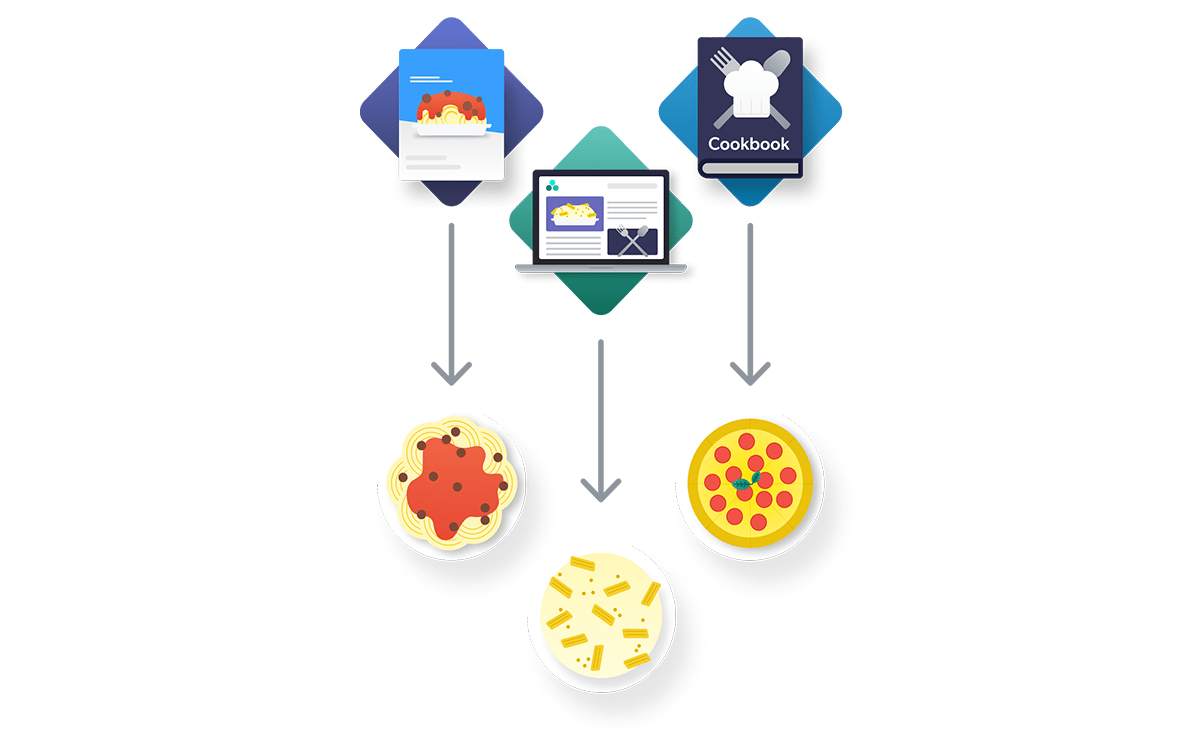
Content lives on your website (or multiple websites), social networks, intranet, and other service providers which tend to be siloed from each other. It may also be housed within internal repositories including your CMS, CRM, or ERP.
Plus, content comes in many forms, like video content, Excel spreadsheets, PowerPoints, blog posts, social media, Google docs, and more.
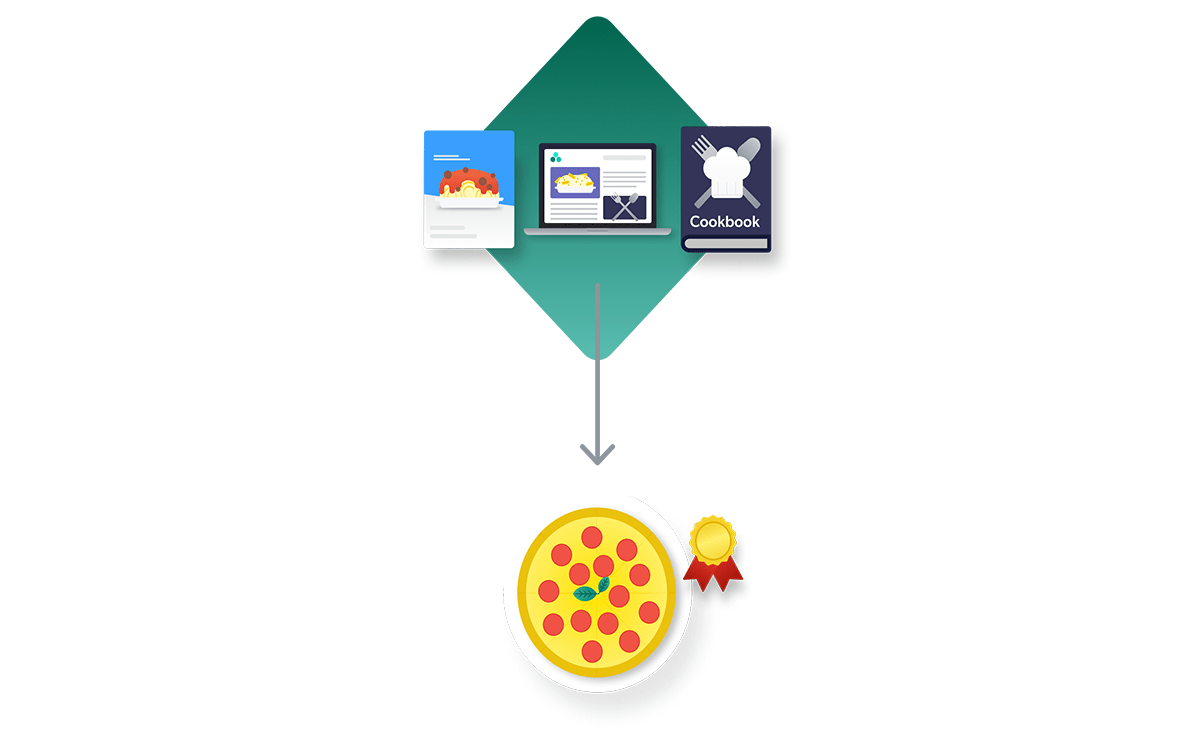
Centralizing access to this content within a searchable index is the first step in making it easier to discover. AI and machine learning further facilitate content discovery through user intent — even when that intent isn’t explicitly stated.
Why Is Content Discovery Important?
Content discovery helps a user’s search experience meet their expectations. We’re all used to getting relevant results no matter where we search. That could be your website, intranet, product page, customer portal, or sales platform (to name a few places).
Nearly 90% of customers say they’ll pay more for a better customer experience — as in, when it’s easy to find what they’re looking for, customers spend more.
Companies like Google, Amazon, and Walmart set a high bar when it comes to good user experience for search. They understand that great content amounts to more audience engagement and better serves consumers.
They excel at delivering high quality content that resonates with individual consumers based on their specific needs. And this type of consumer experience is informing B2B expectations.
Over 70% of B2B buyers demand personalized buying experiences from sellers and vendors.
A content discovery tool that’s powered by AI helps you meet these buyer expectations by:
- Improving the impact of your content (e.g., content velocity) and facilitating better content discoverability.
- Continuously learning from user behavior to boost content relevancy over time.
- Closing the gap between visit and conversion by surfacing the right content recommendations quickly.
- Improving the self-help success rate of users and customers by helping people effectively serve themselves.
- Using intent to match content with each individual user.
- Connecting content from disparate sources (e.g., content silos) to create a unified index of content.
How A Unified Index & AI Can Elevate Content Discovery
From Splintered to Seamless
Before you can make your content fully discoverable, you need to unify access to your content sources.
That means creating a unified index of content that AI can draw on — along with behavioral user data — to deliver content curation and personalized results.
A unified index combined with AI enhances content discovery by avoiding the silo mentality that creates fragmented search experiences.
Fragmented search is when users need information, but they’re not sure where that information exists. For a customer, this means a different experience whether they’re searching on a brand’s ecommerce site, service portal, educational library, etc.
They’ll start their content research from one of those various silos. But because content access isn’t centralized, search results are limited and often incomplete.
So, they begin a new content search, in a new silo — lather, rinse, repeat.
Not a great experience, right?
Resolving Content Silos
How an index helps
A unified index solves the problem of performing the same search repeatedly across multiple sources.
It does this by connecting access to this content and making it available in designated search hubs, which can exist throughout your digital experience.
Imagine centralized access from a search bar on your website homepage, or from your self help portal, or your educational library.
The content served up in these search hubs can come from a variety of sources:
- Your website
- A CMS like Sitecore or Adobe Experience Maker
- A knowledge management platform like Confluence
- An intranet
- CRM and service management tools like Zendesk
- Enterprise applications like Salesforce or SAP
- A video and streaming service like YouTube or Vimeo
This content is then indexed, and surfaced in the above mentioned hubs by a search engine.
How AI helps
A layer of AI and machine learning enhances your search engine by ranking content according to metrics like user engagement.
Unified search lets your customers search for answers across your entire content ecosystem — including content stored in the cloud or on-prem — from a single user interface. Since results are sourced from the unified index, query response time is fast.
Content discovery software that uses AI is what makes it possible to personalize search results for each individual user. AI uses data and machine learning to understand the user’s intent and retrieve relevant content pieces.
Multiple repositories can be made searchable and augmentable, depending on the person typing into the search box.
For example, if you’re a customer support representative and you search for “macbook pro battery life,” the AI uses information about you, combined with machine learning algorithms, to understand your intent. In this case, you need content that will help you answer a customer’s question.
If you’re a customer searching for “macbook pro battery life” on a brand website, the query now has a completely different intent. In this case, AI recognizes that you need content to help you make a purchase decision.
In both cases, the AI interprets the user’s intent, then surfaces different content based on context and behavior.
So, although both users entered the exact same query, the results are different.
10 Features to Look For in a Content Discovery Platform
At Coveo, we think of successful content discovery through a relevance lens.
To achieve it, you need technology that connects your owned content with the people who interact with it.
There are 10 key features that drive a best-in-class content discovery platform. They include:
1 ) Crawling modules/custom connectors
Pulls content from on-prem and cloud systems, and pushes it to the search index (without triggering security warnings). Look for built-in connectors and SDKs that let you create custom connectors to any source of information.
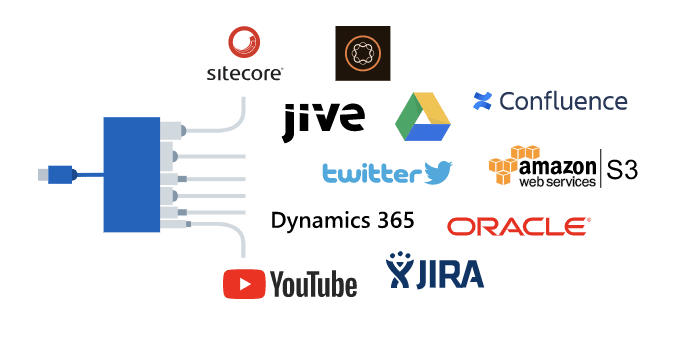
2) Ranking rules management
Provides full visibility of how search results are ranked. And this lets you combine featured results and ranking expressions in one place. Also lets you control the timing of each rule activation (for example, so you can create timed rules for specific promotions or campaigns).
3) Dynamic facets powered by AI
Pulled from metadata, search facets help users refine their search result.
Dynamic facets act without human intervention, choosing the most appropriate facet for each individual user in what order (for example, a user searching for “loveseat” will see different facets than one searching for “office chair”).
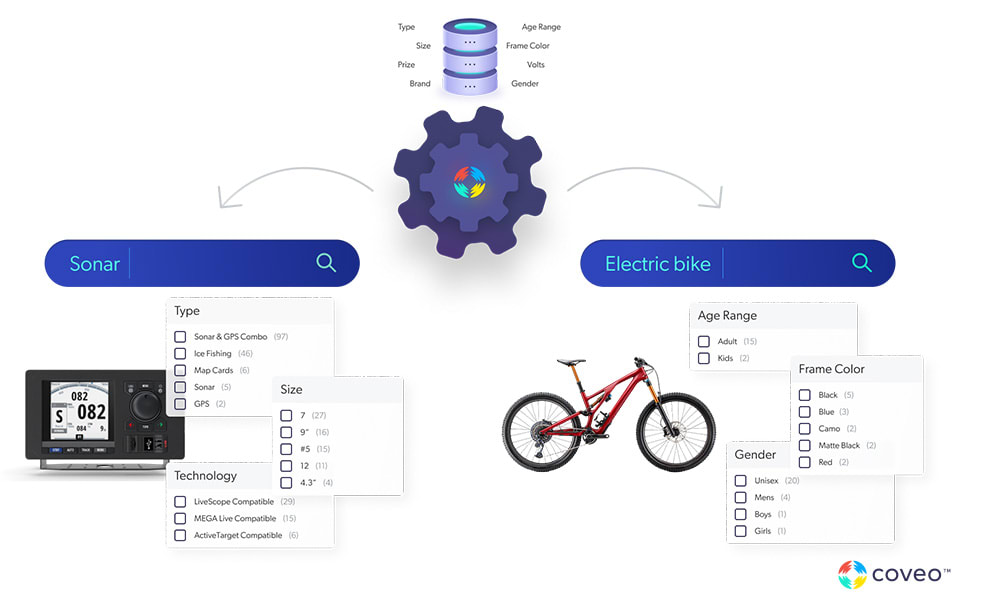
4) Machine learning models like generative answering
Generative answering, a specific application of generative AI, is responding to conversational queries and questions with relevant, individualized generated answers.
By leveraging a large language model, swaths of information can be synthesized and served to a user in real-time, helping them make informed decisions faster.
5) AI-powered personalized recommendations
Guides users to the content most likely to resonate with them based on product associations and in-session actions.
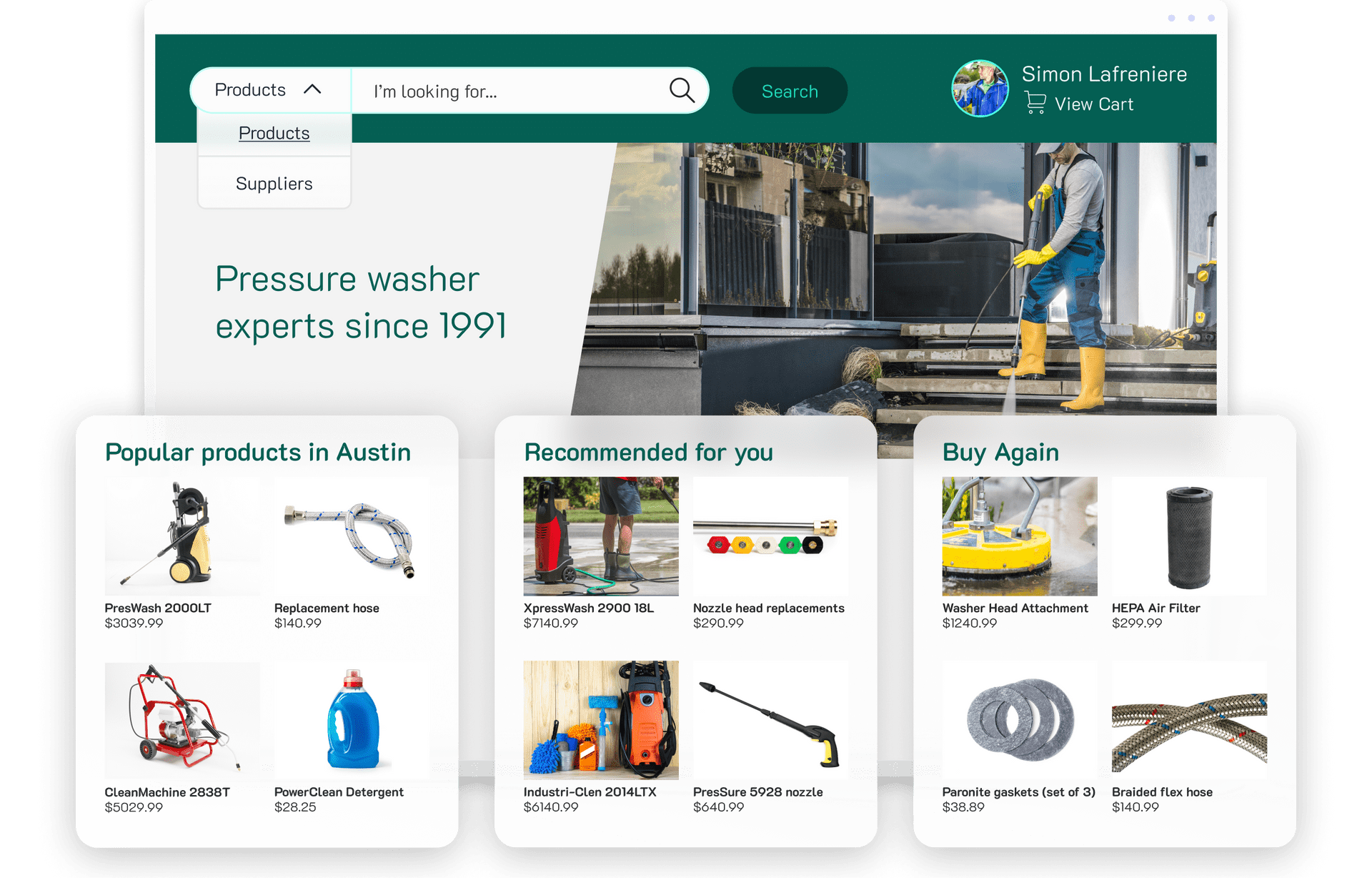
6) In-product experience
Delivers in-app contextual help for customer service, sales, and other employees.
AI-driven content recommendations and results surface within a specific app (e.g., Salesforce, HubSpot, your own product, etc.) providing appropriate content based on user-specific context (making it much easier to provide real-time support).
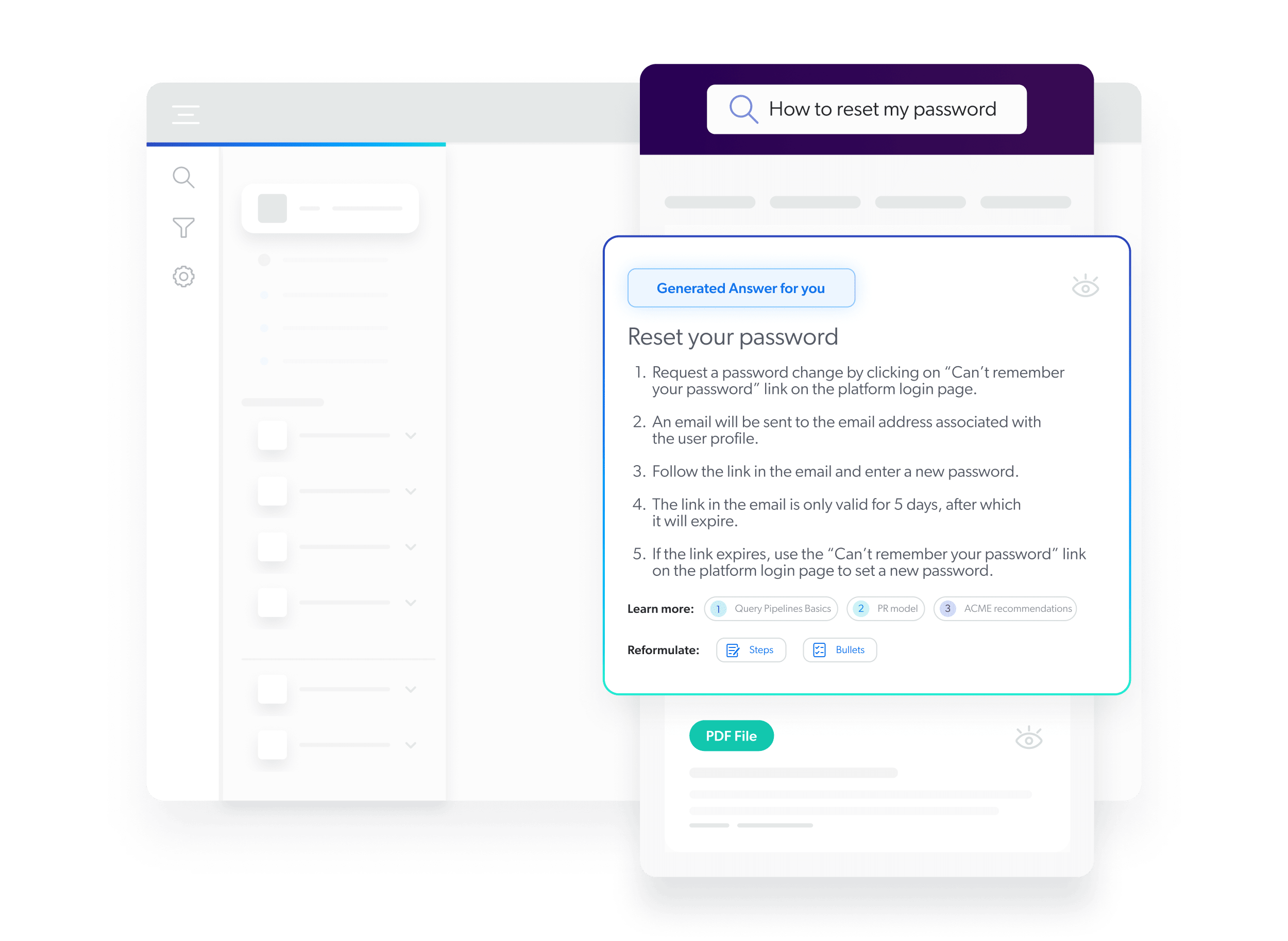
7) Headless UI components
Provides a set of headless UI components that can be dropped into any existing web application.
This lets you take advantage of the power of content discovery without having to do a complete rip-and-replace of your existing tech stack.
8) Fast time-to-market
A system that’s easy to set up and configure. You should be able to move from ideation to content creation to integration quickly.
The ingredients to make this happen include an accelerator for building custom components, a way to unify multiple code bases, and a collection of crowd-sourced components.
9) Critical updates
Cloud-based systems with ongoing updates and frequent releases ensure that you’re always using the latest and greatest features — a true subscription to innovation.
Providers should give you ample notice of new updates and access to a sandbox so you can test how changes impact your content and user experiences before they’re pushed to production.
10) Data residency control
Allows you to specify where content should be stored and replicated so you can maintain control over your data.
In some cases, you may need to keep content within a certain geographic area due to privacy or compliance regulations like GDPR.
Let Intelligent Search Improve Your Content Discovery Method
Intelligent search uses AI to understand user queries and match them with the most relevant content. This translates to a better content discovery experience for users who are much more likely to find what they need quickly — as well as what they’ll need next.
It also helps content creators focus on what’s important to users so they can produce better, more relevant content ideas that resonate with your target audience.
AI search can also help you understand what users aren’t finding — especially when it’s something they’ve searched for. These content gaps can really mar your search experience. Learn more about what they are and how to remove them.
Dig Deeper
To learn more, download our eBook, How to Boost Conversions With Intelligent Site Search which explains how to implement effective search-to-conversion accelerators.
It also covers some of the key points of content discovery, including how to use AI to improve content discovery, implement UX best practices you may be overlooking, and understand why successful searches are twice as likely to convert.


